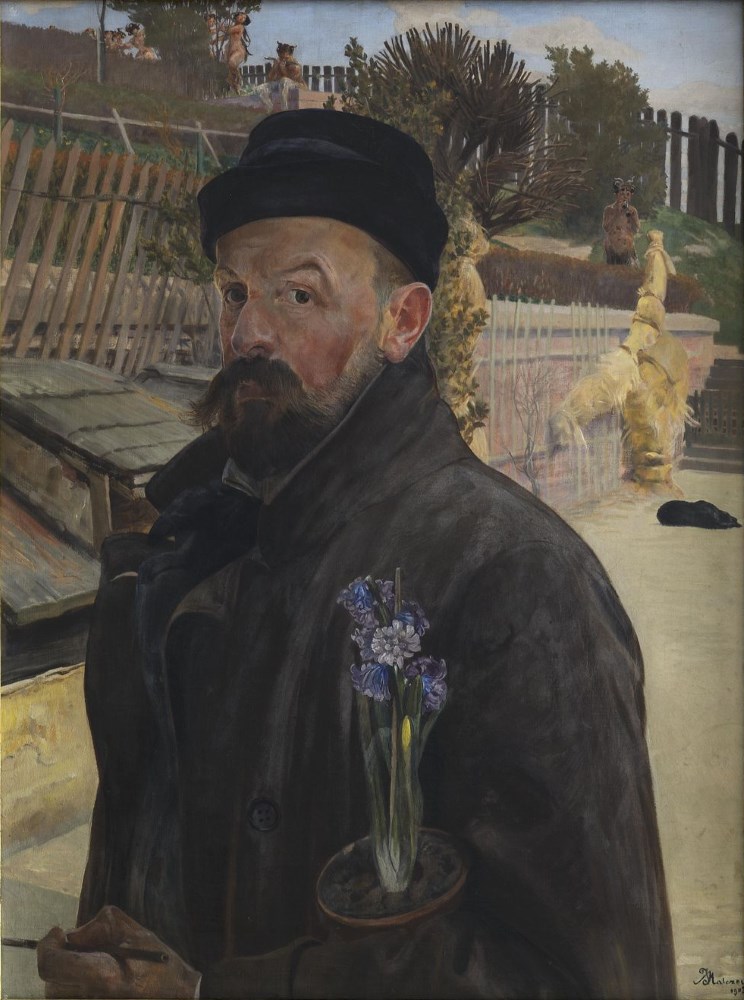Description:
Jack Malczewski (1854-1929) had an affinity for art and romantic literature, especially the poetry of Juliusz Słowacki, which he brought from his family home. He came from a noble, but impoverished family. His father Julian supported him in his painting career. The events of 1863, the January Uprising and subsequent repressions left a special mark on the young artist. His first teacher was Adolf Dygasiński. He spent his youth from 1867 to 1871 in the manor of his uncle Karczewski in Wielgie. In 1873 he began his studies at the School of Fine Arts in Krakow under the tutelage of Jan Matejko. He was a student of Władysław Łuszczkiewicz. He also studied at the École des Beaux-Arts in Paris. He traveled to Italy, Vienna, Munich, Greece, and the Minor Asia. From 1896 to 1900 and 1910 to 1914 he was a professor at the Academy of Fine Arts in Krakow. In 1912-1914 he was its rector. He began with a idealizing realism, then naturalism, his works in this period were dominated by the fate of exiles to Siberia and the inspirations of Juliusz Słowacki’s “Anhellim”. At the same time, fantastic and allegorical views began to appear in Malczewski’s work. After his father’s death in 1884, the recurring motif in Malczewski’s work was Thanatos – the god of death. After 1890 his art became completely symbolic. Works manifesting the turn towards symbolist style are: “Introduction” 1890, “Melancholia” 1890-1894, “Vicious Circle” 1895-1897. The artist took up existential, historical topics, concerning the position of the artist, his obligations to his homeland and the condition of art. He intertwined classical and biblical themes with native folklore and the so important Polish landscape in his work. Form, color, monumentality of representations and their expression became his hallmark.
Description of the painting:
According to Zygmunt Batowski, Jack Malczewski’s Tales I and Tales II were displayed together with the Self-Portrait with Hyacinth as the central representation, creating a layout resembling a triptych. Let’s take a look at this exceptional work. In the foreground we can see a half-figure of the artist, looking at us penetratingly. He is wearing a black coat and a winter cap. With his left hand he is pressing a pot with blue-violet hyacinth to his side. In his hand he holds a brush. The painter is standing in a home garden, most likely in Krakow’s Zwierzyniec, where he lived from 1900. In the background you can see numerous fences, between which dancing and playing fauns and bacchantes move. On the path behind the artist lies a black dog. Against the fragment of the wall are propped recently removed chochoły. The nature is awakening to the sound of faun music.
The symbolism of the spring-announcing flower seems to be obvious. The name Hyacinth comes from the intense in its color and scent of the hyacinth. Its mythological origin brings up a tragic story. Hyacinthos was a favorite of the god Apollo. He was teaching the boy how to shoot with a bow and play the lyre. Unfortunately, the appearance of the young man also attracted the attention of Zephyr, who developed a strong, unrequited feeling for him. The god of the wind could not bear rejection. When Apollo was spending time with his beloved companion, during the game Zephyr blew a gentle breeze that directed the disc thrown by the god so that it hit the boy fatally. From his blood that sprinkled the ground, a flower grew, in memory of the grateful Hyacinth, called hyacinth. It is called the flower of love, but also of sadness and longing. Its presence becomes a kind of warning against the possibility of sudden loss of what brought us happiness and gave meaning to our actions. It should be noted that the name “hyacinth” was also assigned to the precious stone, which symbolizes the achievement of spiritual perfection and humility.
The visible storks in the image no longer fulfill their protective function. They are also not, as well known from Wyspiański’s Wedding, a symbol of paralysis and inability to undertake any action. It is not they who surrender to the pleasures of the stork dance. Considering the season, their presence in the work is not marked either negatively or positively. In spring, storks are unnecessary, as they have already fulfilled their task in winter. Their passivity is therefore a natural consequence of changing circumstances.
Completing the interpretation of the work are the fauns appearing in the garden. Here their untamed nature is revealed, absent in the triptychs of Fairy Tales. Satyrs and maenads are faithful servants of Dionysus. They may represent “reality created by art”**, marked by primitive instincts, referring to the senses, physical. In contrast, Hyacinth, who was the companion of the god Apollo. The story associated with him leads us to the harmonious spiritual, symbolic, moderate sphere.
The art portrays both Dionysian and Apollonian elements, as Nietzsche describes. However, on Malczewski’s self-portrait, the rift between the two is subdued by the majestic and dark colours of the symbolic figure of the artist. Bachic dances remain in the background, separated by numerous barriers. We have a work here that not only depicts the physical but also the spiritual, ideological image of Malczewski – the painter. Defined by the accompanying cycles of Fables I and Fables II.


